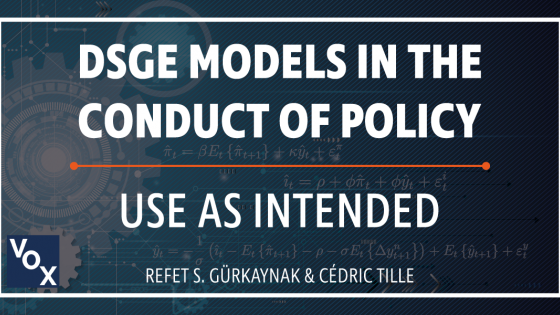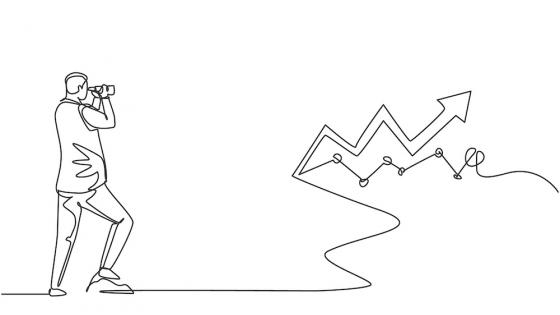Dynamic Stochastic General Equilibrium (DSGE) models have become part of many central banks’ toolkits since the 2000’s (a far from exhaustive list of examples are Board of Governors 2017, Del Negro et al. 2013, Dib 2001, Rudolf and Zurlinden 2014, Smets and Wouters 2003). Yet, this framework has come under heavy criticism because of shortcomings such as too narrow a focus, a reliance on disputable assumptions, or a “mathiness” imposed for its own sake (see for instance Blanchard 2016, Korinek 2015, Romer 2016).
In a new eBook (Gürkaynak and Tille 2017) we survey the use of these models among policy makers and researchers. While the shortcomings are real, the models are in policy use and researchers have been working on finessing DSGE models. The models thus already have their place as one of the tools of central bankers, albeit not an exclusive one.
Download the eBook here:
Policy Lessons
- DSGE models have their place in the toolbox of policymakers. They are particularly useful as internally-consistent frameworks to contrast alternative policy scenarios.
- DSGE models of earlier vintages had clear limitations, but these can be - and are being -- addressed in richer versions.
- As with any model, DSGE should be used bearing in mind the underlying hypotheses and focus. Policymakers have found that relying on a series of complementary models is a much fruitful approach than trying to build the right model.
- Building, maintaining and extending DSGE models is resource intensive so their use in policymaking should be well thought through before investing in these models.
Where are DSGE models coming from?
DSGE models’ use in policy analysis is the current pinnacle in a long tradition of relying on formal models. Macroeconomic policy analysis using formal models began in earnest in 1960s with the large-scale Keynesian settings which were built on behavioral equations. These were easy to tweak as functional forms and variables to be included could be chosen at will by the researcher. Importantly, expectations were treated as, essentially, independent variables. Then came the Lucas critique in the 1970’s, which argued that agents who understand the world do not make inefficient forecasts, that their expectations are rational, and their behavior changes in response to shifts in policies. In terms of modeling, this required expectations to be endogenous and model consistent. While this was a major challenge for the extant macroeconomic models, microeconomic theory was unscathed.
DSGE models result from the understanding that policy analysis can only be satisfactorily carried out when the optimizing behavior of agents at the microeconomic level is well understood. In contrast to old-style, Keynesian macroeconometric models that relied on ad-hoc behavioral relationships, DSGE models rest on microfoundations. The first set of models to have microfounded, optimizing behavior, rational expectations and a general equilibrium framework were the non-monetary real business cycle (RBC) models, focused on the impact of technology shocks (see Plosser, 1989, for an accessible overview). While these early DSGE models showed that business cycle research is possible without being subject to the Lucas critique (1976), they did not leave much scope for monetary policy analysis.
Usefulness for policy analysis, with limits
DSGE models have since been extended to encompass a role for economic policy. They include various inefficiencies and frictions, almost always including price stickiness, allowing for nontrivial policy analysis with an emphasis on monetary policy. In different guises and with different bells and whistles, these New Keynesian models are the current state of the art in monetary policy research (Clarida et al. 1999, remains an excellent primer).
One could get the impression that DSGE models are the latest vintage in a progression of models, each better than the one before, and that the DSGE approach is better than all the previous ones. Much like car vintages, older vintage models still have their fans and indeed may actually be better in some or all dimensions despite the technical improvements in more recent models.
As pointed above, the DSGE approach has come under criticism. In a nutshell, the critics point that the technicalities overly restrict the set of questions that the models can address. This is especially worrying as the unaddressed questions (at least in early versions) include financial frictions, crises and panics, all key dimensions of the recent crisis.
Are DSGE useful to policy makers?
Are DSGE models thus a waste of intellectual energy? This question is highly relevant not only in academic terms, as the models play a central role in macroeconomics, but also in terms of policy, as central banks make substantial use of these tools, with non-negligible implementation costs. The current workhorse policy model (Smets and Wouters, 2007) is a massive undertaking, even in its standard form, without much embellishment. Should we thus be concerned that policy can become misguided or resources wasted?
In Gürkaynak and Tille, we take stock of the use of DSGE models in policy institutions. Our view is that the usual caveat of theoretical analysis applies: use a DSGE framework, or any model for that matter, only for the question that it was designed to handle. This “good old wisdom” statement implies that one should be mindful of when to rely on a DSGE model, but also be open to using other approaches for questions that DSGE models are not (yet) fit to handle.
In fact, this volume shows that the DSGE framework is not seen as the right one by policy makers. Instead, central banks continue to use large scale macroeconometric models in the older Keynesian tradition, as well as other statistical methods, such as structural VARs for policy analysis and forecasting (see Edge and Gürkaynak, 2010, for a forecast comparison exercise), in addition to DSGE models.
Our review relies on contributions from nine sets of authors and is presented around three sections. The first section, which contains the assessments of policymakers, considers how DSGE models fit in the broader toolbox of policymakers. We then delve into the lessons learned from the building and use of these models, with contributions from some of the foremost practitioners of the art. The final section assesses the way forward, with two essays by two of the founding fathers of DSGE modeling.
How do DSGE model fit in the toolbox?
In DSGE Models: A Cup Half Full, John C. Williams stresses that DSGE models are only one of several inputs in the policy process. The reliance on several types of models allows for a robustness check of the key macroeconomic features. While there is a large body of work developing and strengthening DSGE models, some major areas need additional efforts. These include the workings of the labor market, the inclusion of long cycles to better capture persistent changes, and a richer view of financial markets and their imperfections.
The chapter by Katrin Assenmacher, Bridging the gap between structural VAR and DSGE models, contrasts DSGE models with the more data-oriented VAR approach. It stresses that the two approaches are not as far apart as one may think, with for instance SVAR frameworks being used to infer the parameters of DSGE models, and the DSGE models providing the necessary restrictions needed for the identification of shocks in a SVAR.
Stefan Gerlach’s contribution, DSGE models in monetary policy committees, points out that policy makers are far from relying only on such models. This limited reliance results from several aspects. The performance of DSGE models during the crisis has been quite disappointing, which highlighted that their deep structural features turned out not to be so deep. In addition DSGE models rely on too limited a set of indicators and economic mechanisms, and can thus miss relevant transmission channels. The complex nature of the models also limits their usefulness as communication devices.
Lessons from DSGE use in policy analysis
Turning to the experience from DSGE use in central banks, Del Negro and Giannoni, in Using Dynamic Stochastic General Equilibrium Models at the New York Fed, review the experience across various uses. While DSGE are not the best forecasting tools, their performance remains strong enough. DSGE models proved useful in accounting for the historical experience, and allow for the computations of estimates of relevant but unobservable variables, such as the natural rate of interest. They also provide a framework for the conduct of “what if” analyses, including providing a sense of the probability of various outcomes. Despite improvements, no model will ever be “the” true model, and thus contrasting the messages across a range of different setups offers the best way to assess the robustness of conclusions.
In Empirical DSGE Models: from the Great Moderation, to the Great Recession and beyond Justiniano, Primiceri, and Tambalotti review the performance of empirical analyses that rely on DSGE models. There has been substantial progress on methods, with the use of Bayesian procedures as well as multi-indicators approaches. The models have proved useful in informing researchers on the sources of business cycles. Nonetheless the crisis has sharply highlighted the limitations of the models, and substantial improvements are being developed to better capture financial frictions, enrich the set of tools of policy makers, and develop settings with heterogeneous agents.
In addition to their use in understanding monetary policy, DSGE settings shed lights on the interactions across various policies. In Policy Packages: Challenge and Opportunity for DSGE Research Fabio Ghironi points out that frameworks built on optimizing behavior are particularly useful in assessing reforms that span several areas of policy. For instance, structural reforms affect the incentives of agents at the micro level, and thus one should assess them using a setting that captures this. These settings also allow the researcher to assess how reforms can be best accompanied by other policies, such as monetary policy.
One of the main appeals of DSGE models is their ability to conduct scenario analysis. In DSGE models and counterfactual analysis Coenen, Motto, Rostagno, Schmidt and Smets stress this aspect. The models fit the data reasonably well and their explicit modelling of expectations limits their vulnerability to the Lucas critique. The authors illustrate the point through several examples, namely the de-anchoring of inflation expectations, an assessment of the drivers of movements in financial markets, and the identification of the shocks behind growth and inflation developments.
What next?
The ebook concludes with two contributions on the next steps. In Some Scattered Thoughts on DSGE Models Gali points out that DSGE models are still lacking in several dimensions. Promising avenues for research include a move away from the standard infinite horizon and representative agent assumptions. DSGE models are also built on the constraining assumption that the economic variables are stationary, and are thus ill-equipped in their current form to handle long lasting shifts.
Blanchard’s contribution, Do DSGE Models Have a Future?, points out that DSGE models rely on constraining assumptions, and that the reliance on a-priori methods (calibration and Bayesian methods) for estimation is questionable. Their normative dimension is also questionable, and often the complexity of the models hinders their use as communication devices. While these limits do not call for abandoning DSGE settings, this line of research has to be broadened to go beyond the restrictive assumptions on which it relies.
A useful tool, among several
What should we conclude from this set of presentations? First, one should not exaggerate the place taken by DSGE models in the conduct of policy. They are only one input out of many that central bankers take into account. Second, the models have a clear comparative advantage in some aspects of policy analysis. Specifically, while one can compute forecasts using several approaches, analyzing “what if” policy scenario requires a framework linking the various economic variables in a transparent and coherent way, making the DSGE framework particularly useful. Third, DSGE models are a work in progress and there remain substantial room for improvement in many dimensions, such as the inclusion of financial cycles and analysis beyond short-term fluctuations.
A final thought, not aired by the eBook authors but made clear by their high demands from what they deem satisfactory DSGE models, is that these models may not necessarily be appropriate for all central banks, at least not in a rich and detailed form. Maintaining and running DSGE models entails substantial staff, data, and computational resources. While this is a manageable issue for central banks with a large enough staff, policy makers in countries with more limited resources should think carefully of where to invest their resources. For such countries, keeping the focus on a small-scale model may be warranted. Such a framework gives a parsimonious sense of the main trends for growth and inflation at a manageable cost.
Having compiled this set of essays from leading policymakers and academic and central bank researchers, it is gratifying to see the extent to which there is agreement on the place of DSGE models in policy analysis. All see these models as part of the policymaker tool kit, while understanding their limitations and perceiving a similar road ahead. This is different from popular critics of modern macroeconomics and DSGE models, who only see failure in this enterprise, mostly due to these models inability in having forecasted the Global Financial Crisis. Contributors of this volume are different in that, regardless of their titles and involvement in the literature, they all understand the building purpose and inner workings of DSGE models. That understanding unites them in being able to make use of these models and in asking for improvements, without aspiring for a model that answer all questions.
There is much to do in DSGE modeling and estimation. This volume shows these models find appropriate policy use, as intended, and justifies the massive effort needed to further refine them.
References
Blanchard, O. (20016), “Further Thoughts on DSGE Models” PPIE blog.
Board of Governors of the Federal Reserve System (2017), “FRB/US Model”
Clarida, R., Jordi G. and M. Gertler (1999), “The Science of Monetary Policy: A New Keynesian Perspective” Journal of Economic Literature 37(4), pp. 1661-1707.
Del Negro, M., S. Eusepi, M- Giannoni, A. Sbordone, A. Tambalotti, M. Cocci, R. Hasegawa, and M.H. Linder (2013), “The FRBNY-DSGE Model”, Federal Reserve Bank of New York Staff Report 647
Dib, A. (2001), “An Estimated Canadian DSGE Model with Nominal and Real Rigidities”, Bank of Canada Staff working paper 2001-26.
Edge, R.M. and R.S. Gürkaynak (2010), “How Useful Are Estimated DSGE Model Forecasts for Central Bankers?” Brookings Papers on Economic Activity 41(2), pp. 209-259.
Korinek, A. (2015), “Thoughts on DSGE Macroeconomics” INET blog.
Lucas, R. (1976), “Econometric Policy Evaluation: A Critique” Carnegie-Rochester Conference Series on Public Policy 1, pp. 19-46.
Plosser, C. (1989), “Understanding Real Business Cycles” Journal of Economic Perspectives 3 (3), pp. 51-77.
Romer, P. (2016), “The Trouble with Macroeconomics” Mimeo, NYU.
Rudolf, B., and M. Zurlinden (2014), “A Compact Open-Economy DSGE Model for Switzerland”, SNB Economic Studies 8 / 2014
Smets, F. and R. Wouters (2007), “Shocks and Frictions in U.S. Business Cycles: A Bayesian DSGE Approach” American Economic Review 97(3), pp.586-607.
Smets, F. and R. Wouters (2003), “An Estimated Dynamics Stochastic General Equilibrium Model of the Euro Area,” Journal of the European Economic Association 1(5), pp. 1123-1175.



